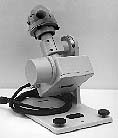Eppley Solar Tracker
 Eppley
Laboratory is the main manufacturer of manually adjusted Solar Trackers
used with the Eppley NIP or Cavity Radiometer. The Model ST-1 (see photograph)
is electrically driven using a clock-based motor
which makes one revolution every 24 hours. These trackers
have to be adjusted manually to account for changes in the declination of
the sun and the changes in true solar time (see
equation of time).
Eppley
Laboratory is the main manufacturer of manually adjusted Solar Trackers
used with the Eppley NIP or Cavity Radiometer. The Model ST-1 (see photograph)
is electrically driven using a clock-based motor
which makes one revolution every 24 hours. These trackers
have to be adjusted manually to account for changes in the declination of
the sun and the changes in true solar time (see
equation of time).Useful alignment tricks
One can make a tube that fits between the flanges of the NIP between the alignment target and the sunlight hole in the top flange. By cutting a window in the tube to see the target, one can more easily align the NIP during periods of intermittent cloudiness.
© 2022, UO Solar Radiation Monitoring Laboratory.
|
Top of page Site map Solar data Instruments Publications |
Home page Search About our data Software tools |
Sponsors Contact us Monitoring stations Educational material |
Home page URL: solardata.uoregon.edu
